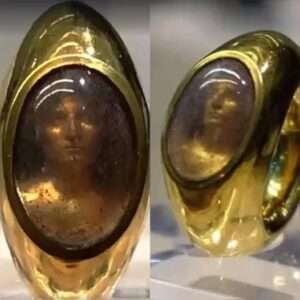An almost 2,000-year-old Roman gold ring recently came to light within the tomb of Aebutia Quarta, situated in close proximity to Rome. This stunning object showcases a rock crystal that has been intricately carved to represent her son, Titus Carvilius Gemello. The back of the crystal bears an engraving skillfully manipulating light, giving rise to a holographic effect that renders the image of Titus Carvilius Gemello remarkably lifelike. Now residing at the Museo Archeologico Nazionale di Palestrina, this remarkable piece offers a glimpse into the advanced artistic techniques and unparalleled craftsmanship of the ancient Romans.
The discovery of the Roman gold ring within the tomb of Aebutia Quarta not only sheds light on the intricate artistry of the ancient Romans but also offers a captivating insight into the personal connections and familial bonds that played a significant role in their lives. The portrayal of Titus Carvilius Gemello on the rock crystal symbolizes the importance of familial ties in Roman society, as well as the artistic prowess and attention to detail that characterized their craftsmanship.

The rock crystal’s ingeniously crafted engraving, capable of manipulating light to create a mesmerizing holographic effect, is a testament to the exquisite skills possessed by ancient Roman artisans. The lifelike representation of Titus Carvilius Gemello serves as a poignant reminder of the artistry and innovation that defined Roman culture.
The relocation of this extraordinary piece to the Museo Archeologico Nazionale di Palestrina ensures that it will continue to be preserved and appreciated for generations to come. Visitors to the museum will have the opportunity to marvel at the ancient Roman gold ring, with its intricately carved rock crystal and lifelike depiction of Titus Carvilius Gemello, and gain a deeper understanding of the artistic achievements of one of history’s most influential civilizations.
In conclusion, the discovery of the Roman gold ring in the tomb of Aebutia Quarta stands as a testament to the artistic excellence and skilled craftsmanship of the ancient Romans. Through the intricately carved rock crystal and its holographic effect, this remarkable artifact offers a glimpse into the familial connections and artistic ingenuity that characterized Roman society. Its preservation at the Museo Archeologico Nazionale di Palestrina ensures that it will continue to inspire and captivate visitors for years to come.





